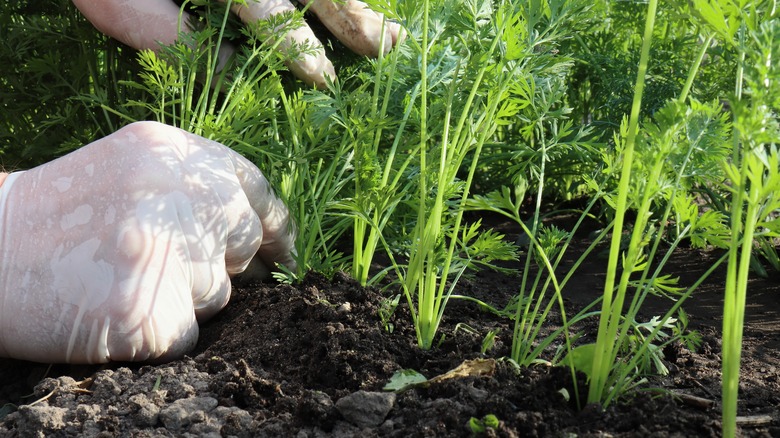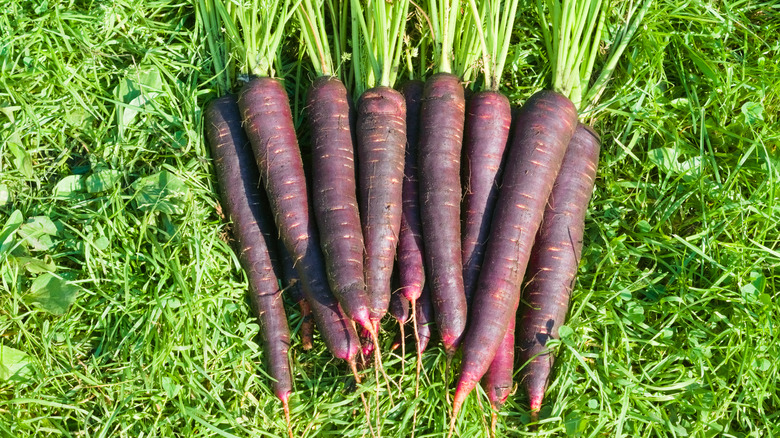How To Grow Purple Carrots: The Unique Addition That'll Add Appeal To Your Garden
There aren't many garden thrills that compare to pulling a carrot from the earth. With a quick hose-off, the sweetness is like nothing you'll taste from a grocery store. Carrots are cheap and omnipresent in markets, so why should you grow them in your home garden? Well, besides the incomparable taste, growing your own vegetables is a chance to sample foods that are hard to find at the local shop. Purple carrots (Daucus carota subs. Sativus) are a lesser-known veggie that you can plant and grow like any other carrot. Varieties include Purple Haze, Cosmic Purple, and Black Nebula. These striking root vegetables will add some wow to your garden that typical carrots don't deliver. Taking the opportunity to plant new vegetable varieties introduces you to flavors you won't find in the produce aisle. To successfully grow these vibrant vegetables, prep your soil, plant the seeds in spring, thin the seedlings, and harvest the carrots at the right time.
Just as tasty and twice as pretty, purple carrots don't require any special treatment that makes them different from other types of carrots. Further, like their orange cousins, they can weather a few frosts that even improve their taste. When you crunch into a freshly-harvested purple carrot fresh from the garden, you'll be tempted to make them a yearly crop.
How to grow purple carrots
Carrots are cool-season vegetables that are among the first you can plant in the spring. If you're short on space, you can also successfully grow carrots in containers. No matter the color, the steps to a bountiful carrot harvest are the same. They do best in light, sandy soil situated in full sun. While many sources recommend planting carrots after the threat of frost has passed, these hardy root vegetables can tolerate — and even improve with — a bit of frost.
Prep your soil before planting so that the texture and nutrient content will help your carrots go from seeds to harvest. Break up any soil chunks, remove rocks, and till the top 10 inches of soil. It's not a bad idea to test the soil before planting; carrots don't develop well in soil that's too high in nitrogen, and they love a bit of organic matter mixed in.
Once your garden's soil reaches about 40 degrees Fahrenheit, plant the seeds in the ground about ¼ inch deep. Water them often but not too deeply, and they may take up to 21 days to sprout. Once the tops are 1 inch tall, thin them to 3 to 4 inches apart by using scissors to cut off the tops of some of the seedlings. After as few as two months, your carrots may be ready to harvest. They are tastiest when you pick them small, but let them reach at least ½ an inch in diameter.
Special considerations for growing purple carrots
Carrots of any variety have a reputation for being hard to grow. Their dust-fine seeds are light enough to be swept away in the wind or by heavy watering, and if your soil has a crust on the surface, you may not see your seeds germinate at all. To avoid these problems, you can cover the seeds with a bit of sand or compost to hold them lightly in place and reduce the worry of crusting soil. There are benefits to planting radishes next to your carrots as well. As radishes grow, they help prevent crusting, and their foliage provides a bit of extra shelter for delicate carrot sprouts.
Carrots are also easily threatened by weeds, and water fluctuations can cause cracking, forking, hairy roots, and bitterness. For the best return on your time investment, keep a close eye on unwanted plants in your carrot patch and gently pull out weeds to avoid disturbing carrot roots. Also maintain soil moisture with regular, moderate watering and a thin layer of mulch.

